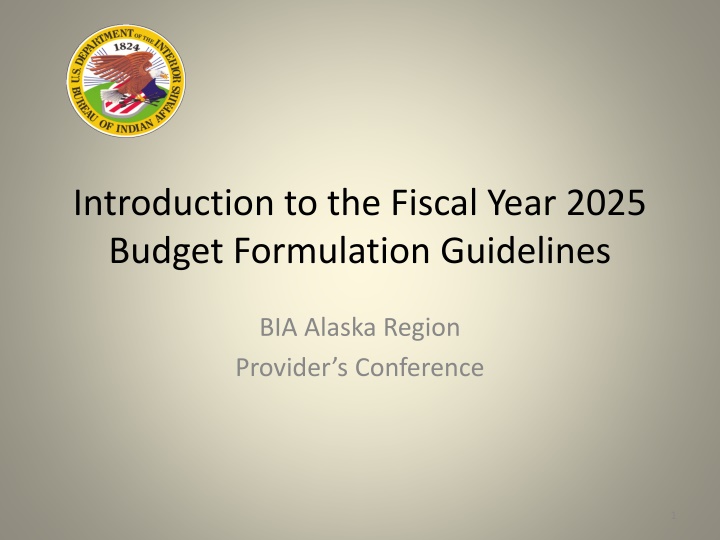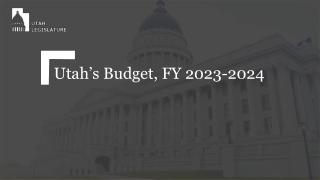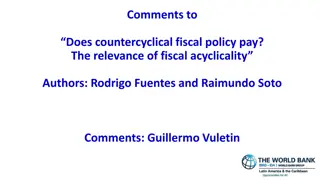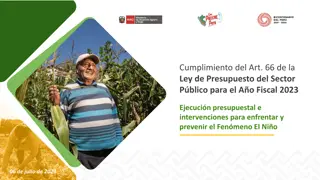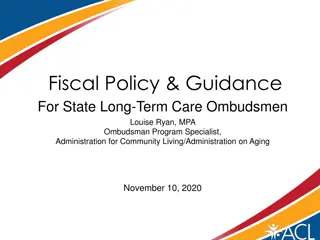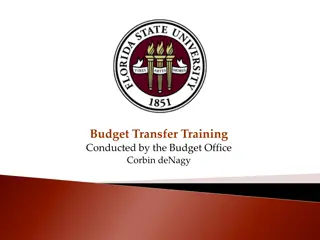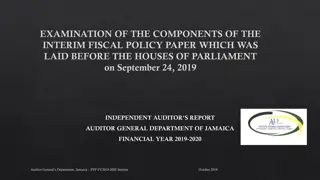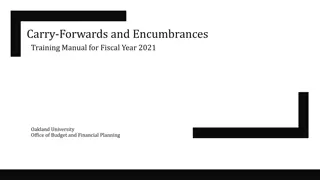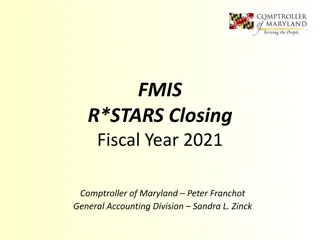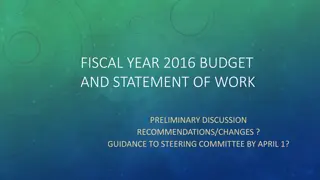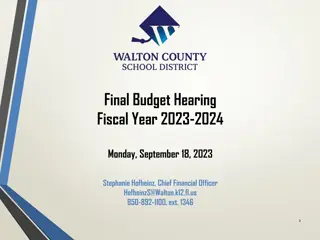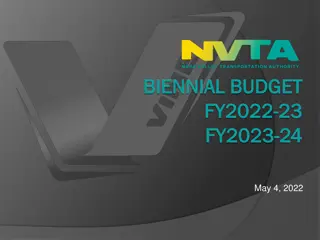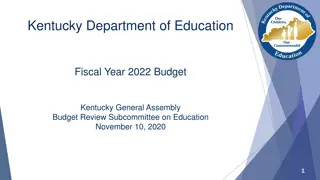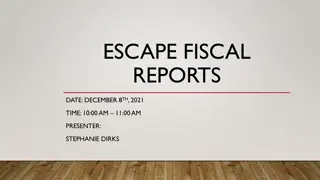Fiscal Year 2025 Budget Formulation Guidelines
The budget formulation process for the fiscal year 2025 involving Alaska Native and American Indian tribes, annual forum for input and recommendations, overview of federal budget processes including President's budget submission to Congress.
Download Presentation

Please find below an Image/Link to download the presentation.
The content on the website is provided AS IS for your information and personal use only. It may not be sold, licensed, or shared on other websites without obtaining consent from the author.If you encounter any issues during the download, it is possible that the publisher has removed the file from their server.
You are allowed to download the files provided on this website for personal or commercial use, subject to the condition that they are used lawfully. All files are the property of their respective owners.
The content on the website is provided AS IS for your information and personal use only. It may not be sold, licensed, or shared on other websites without obtaining consent from the author.
E N D
Presentation Transcript
Introduction to the Fiscal Year 2025 Budget Formulation Guidelines BIA Alaska Region Provider s Conference 1
Regional Office Officials Michelle Watchman, Acting Regional Director Lynn Polacca, Deputy Regional Director Trust Services Michelle Watchman, Deputy Regional Director Indian Service Andrew Gichard, Acting Budget Officer James Atti, Regional Budget Analyst 2
Alaska Region TIBC Representatives Rick Harrison, Chickaloon Nation Karen Linnell, Tribal Rep 3
Introduction The budget formulation process is an annual forum for Alaska Native and American Indian and Tribes to provide input and recommendations for initiatives and policies. Budgets are formulated nearly 2 years before the start of the fiscal year. This year we are formulating the FY 2025 budget. 4
Summary of Federal Budget Process The 5 Basic Steps in the Federal Budget Process are: The process of ranking programs by Tribes is part of the starting point in formulating the President s 2025 Budget Request to Congress 1. The President submits a budget request to Congress Lawmakers release their own budget plans and set overall spending levels with a budget resolution House and Senate subcommittees set funding for each program through appropriations bills House and Senate members come together to resolve differences in their appropriations bills The budget returns to the President for signature before it becomes law 2. 3. 4. 5. 6
The Presidents Budget to Congress The President is required each year to submit recommended budget levels for Federal programs to Congress Formulation of the President s Budget recommendations marks the beginning of the Annual Budget Process The budget request, known as the President s Budget Request, is developed through an interactive process between Federal Agencies and the President s Office of Management and Budget (OMB) The Congress does not have to enact the budget at the levels that the President recommends 7
Timeline of Presidents 2025 Budget Development March 2023: Federal Agencies begin to formulate their budgets Spring/Summer 2023: OMB Guidance to the agencies September 2023: Agencies submit their budget requests to OMB September/October 2023: OMB works to reconcile requests with Presidential Priorities October/December 2023: Passback of OMB revisions to the Agencies and Finalization January 2024: Agencies and OMB develop Budget Justifications for Congress February 2024: Publication of the Budget & Submission to Congress (known as The Green Book) 8
Role of the Tribal Interior Budget Council (TIBC) The Tribal/Interior Budget Council was established in 1999 (formerly TBAC) TIBC s mission is to provide an advisory Government-to-Government forum and process for Tribal Nations and the Department of Interior, to develop budgets that allow for the fulfillment of Tribal Nations self-determination, self- governance, sovereignty, and treaty rights through program funded levels that address the obligations of the federal government to Tribal Nations and their citizens 9
What Role do Tribes Play in the Process? BIA must consider several things when formulating their budget request: What do tribal nations prioritize? Based on TIBC s Final Priorities Report and input from the TIBC Budget Subcommittee What programs have been measurably successful? What programs have been unsuccessful? What programs are mandated by law. What pressing issues and Presidential Priorities need to be addressed and how? (i.e. funding to combat opioid addition) 10
TIBC Process Timeline September/October: Indian Affairs updates Formulation Guidance and the Priority and Ranking Tool and releases to regions/tribes. November/January: TIBC convenes first session of the fiscal year in November. Regions hold Formulation Meetings with Tribes. February: Tribal rankings are due. Regions prepare and submit consolidated submissions. March/April: Indian Affairs presents national ranking tool rollups and priorities, TIBC deliberates on final budget strategy. Budget sub-committee presents numerical recommendations. July: Review the status of Indian Affairs appropriations, obligations, and outlays. Review any congressional action and current budget related developments. 11
What does Indian Affairs do with the Program Rankings? Why is it that the final President s budget request doesn t always reflect TIBC recommendations? Indian Affairs integrates the TIBC/Tribal recommendations into their request to the head of DOI to the best of their ability considering the internal guidance and other restrictions that are placed on them from within their Department or from OMB. DOI s hands are ultimately tied by OMB and the President. Even if the Secretary of DOI includes TIBC s recommendations in their request it might still change based on the President s Priorities. When guidance requires Indian Affairs to prepare a decreased budget, Indian Affairs incorporates TIBC recommendations by using the tribal ranking within categories to determine which programs are of lower priority and applies the decreases there. 12
Tribal Input is Valuable! DOI has a legal obligation to consult with tribes on budget matters and all matters that impact tribes. TIBC s annual recommendations are not only helpful to DOI They are also a helpful tool to use to educate Congress and Congressional appropriators. Bringing TIBC s recommendations to Congress can be sometimes a more effective means of impacting the ultimate Federal Budget numbers than presenting them within the DOI process. 13
Budget Formulation Documents 2025 Formulation Guidance Attachment A Formulation Timeline Attachment B CO Budget Priority Template Attachment C Regional Budget Priority Template Attachment D Tribal Preferred Program Ranking Tool Attachment E Regional Final Ranking Tool 14
Strategic Program Funding Categories 1. Strengthening Tribal Communities (9 programs) 2. Trust Natural Resources Management (15 programs) 3. Trust Land & Water Rights Management (17 programs) 4. Public Safety and Justice (10 programs) 5. Economic Development (6 programs) 6. Education (20 programs) 7. Construction (12 programs) 8. Resource Management Construction (7 programs) 15
Timeframe for Meetings and Document Submissions October, 2022 January, 2023: Tribes rank programs DUE DATE FOR RANKING SUBMISSIONS: Tuesday, January 20, 2023 (proposed) February XX, 2023 (proposed): Regional Office hosts a 2nd budget meeting February 24, 2023: Regional submission (Alaska Region Office) of program ranking summary and regional priorities to Central Office. 16
FY 2023 Regional Program Ranking Results Strengthening Tribal Nations Aid to Tribal Government (TPA) #1 Trust Natural Resources Mgmt. Wildlife & Parks (TPA) #1 Trust Land/Water Rights Mgmt. Alaska Native Programs(TPA) #1 Public Safety & Justice Tribal Courts (TPA) #1 Economic Development Economic Development (TPA) #1 Education Scholarships & Adult Education (TPA) #1 16 tribes in Alaska Region responded in 2021 Data was combined with 23 in 2020, and 55 in 2019. 17
Final Regional Submissions (Responsibility of the Budget Office) Consolidate and provide to Central Office, Office of Budget and Performance Management, a report of the final tribal regional ranking summary (Attachment E) Provide to Central Office, in ranking order, the regional priority document(s) (Attachment C) 18
Use of the Information Program category rankings will be presented at the Tribal Interior Budget Council (TIBC) National Budget Meeting in March/April, 2023, to assist the full TIBC body in deciding the FY 2025 Budget Formulation Strategy for Indian Affairs 19
FY 2025 Ranking Tool (Attachment D) The tool is an adobe .pdf document The tool includes program definitions Not every program in each category has to be ranked There should only be one complete submission for each tribe Tribes will email their completed ranking to; TribalFormulations.TIBC.Budget@bia.gov and to ak.tibc.budget@bia.gov 20
Demonstration of the Preferred Program Ranking Tool and Explanation of Programs (Attachment D) 21
Strategic Area Level Ranking 1. Strengthening Tribal Communities 2. Trust Natural Resources Management 3. Trust Land & Water Rights Management 4. Public Safety and Justice 5. Economic Development 6. Education 7. Construction 8. Resource Management Construction In addition to the program ranking within each strategic area, tribes will be asked to rank the actual strategic areas in order 22
Overview and Demonstration of the Strategic Area Ranking Tool 23
Open Discussion The End 24
